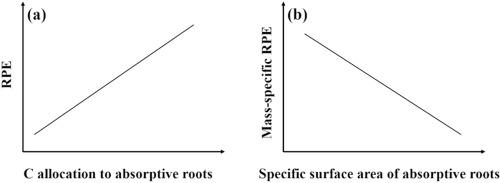Soil Biology and Biochemistry ( IF 9.7 ) Pub Date : 2020-09-06 , DOI: 10.1016/j.soilbio.2020.107997 Liming Yin , Wen Xiao , Feike A. Dijkstra , Biao Zhu , Peng Wang , Weixin Cheng

|
Woody plant roots can be classified into absorptive roots and transport roots based on root functions, order and traits. While there is an emerging view that living roots actively affect soil organic carbon (SOC) decomposition via the rhizosphere priming effect (RPE), the linkages of the RPE with C allocation to absorptive roots (relative to total roots) and their functional traits across soils are virtually unknown. Here, we investigated the RPE by growing a tree species (Chinese fir, Cunninghamia lanceolata) in three isotopically-distinct C4 soil types with different soil properties such as C/nitrogen (N) ratio and texture, and by growing three tree species (Chinese fir, larch (Larix kaempferi) and ash (Fraxinus mandshurica)) with wide variations in root functional traits in one of the C4 soils. We classified living roots into absorptive roots (first and second orders) and transport roots (third and higher orders) and then quantified their C allocation (relative to total roots) and morphological and chemical traits associated with economic construction, rhizodeposition and resource acquisition. We found that the RPE of Chinese fir across the three soils decreased with an increase in soil C/N ratio. This result conflicted with the N mining hypothesis and suggests that soil C stabilization mechanisms associated with clay minerals may play an important role. Further, significant differences in the RPE among tree species were largely accounted for by the C allocation to absorptive roots. Moreover, there was a significantly negative relationship between specific surface area of absorptive roots and the specific RPE (per unit biomass of absorptive roots) among tree species, suggesting that absorptive root traits shaping the extent of the rhizosphere may regulate the RPE. Taken together, our results provide evidence that absorptive roots play a predominant role in causing the RPE. These findings present an important step toward improving our capability to predict plant effects on SOC decomposition through linking the RPE to absorptive root functional traits.
中文翻译:

将吸收性根及其功能性状与树种的根际引发联系起来
木本植物的根可以根据根的功能,顺序和性状分为吸收性根和运输性根。尽管有新的观点认为,活根通过根际启动效应(RPE)积极影响土壤有机碳(SOC)的分解,但RPE与C分配对吸收根(相对于总根)的联系及其在土壤中的功能性状几乎是未知的。在这里,我们通过在三种具有不同土壤性质(如碳氮比和质地)的同位素不同的C 4土壤类型中生长一种树种(杉木,杉木)来研究RPE ,并通过生长三种树种来研究RPE。杉木,落叶松(Larix kaempferi)和灰(Fraxinus mandshurica))C 4之一的根部功能性状差异很大土壤。我们将活根分为吸收性根(一阶和二阶)和转运根(三阶和更高阶),然后量化其碳分配(相对于总根)以及与经济建设,根际沉积和资源获取相关的形态和化学特征。我们发现,杉木在三种土壤上的RPE随土壤碳氮比的增加而降低。这一结果与氮的开采假说相矛盾,并表明与粘土矿物有关的土壤碳稳定机制可能起重要作用。此外,树种之间RPE的显着差异很大程度上是由于对吸收性根的碳分配所致。此外,在树种之间,吸收性根的比表面积与比重RPE(吸收性根的单位生物量)之间存在显着的负相关关系,这表明影响根际范围的吸收性根性状可能会调节RPE。两者合计,我们的结果提供了证据,表明吸收性根在引起RPE中起主要作用。这些发现为通过将RPE与吸收性根功能性状联系起来,提高我们预测植物对SOC分解的影响的能力迈出了重要的一步。



























 京公网安备 11010802027423号
京公网安备 11010802027423号